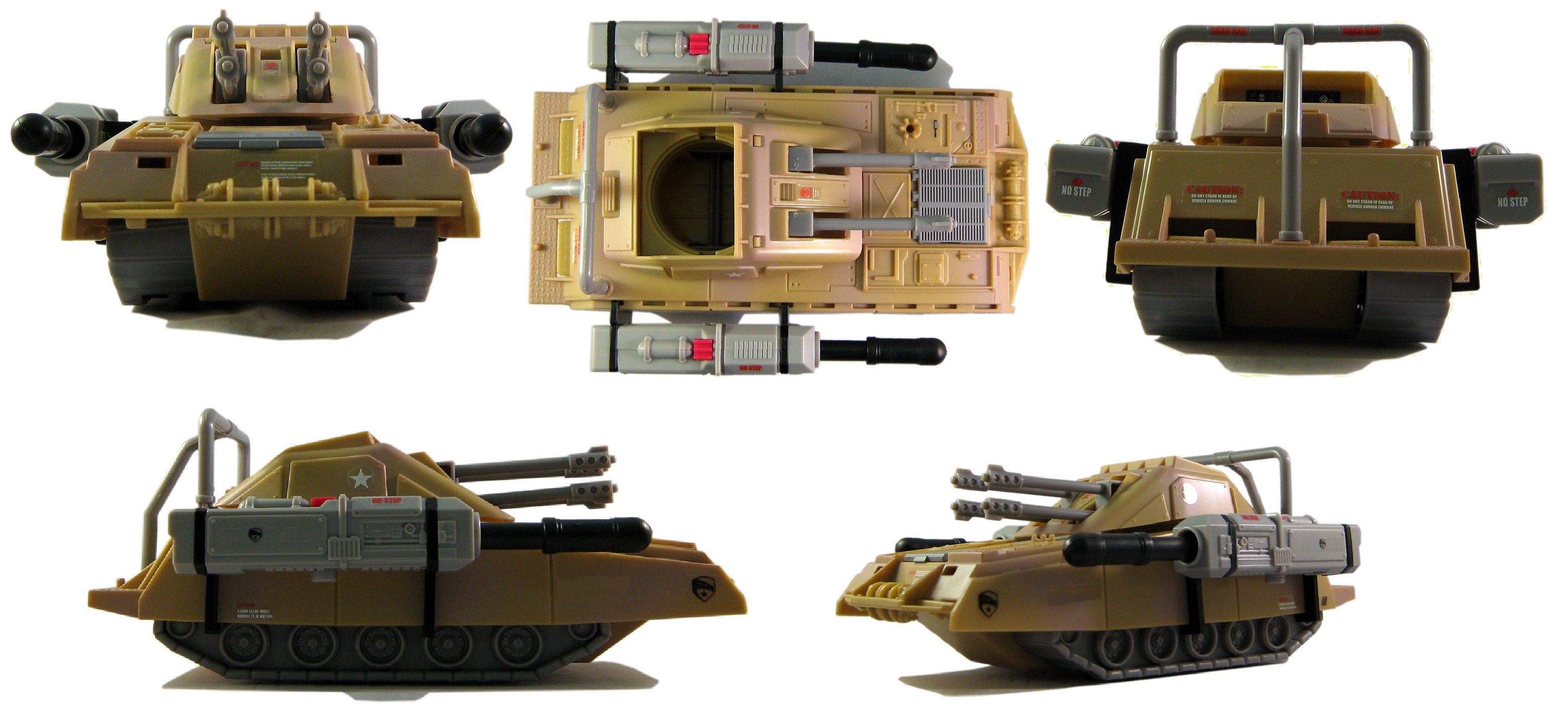 | Anti-Aircraft Tank. |  | |||
|---|---|---|---|---|---|
The Armadillo would have become part of the scrap heap of history, yet another clever but failed program (like many of the early armored cars developed for the First World War that couldn't traverse No Man's Land), had not the Global War On Terror broken out: The British pulled the only example of this vehicle out of storage when the London Uprising threatened to storm the Royal Palace. The tank smashed through the mob, then the driver opened fire, killing approximately 200 would-be suicide stormtroopers. How exactly the REF came to be in possession of the tanks, though, is not clearly understood; The tanks was supposed to be left with the ASC, but the records with the vehicles indicated the vehicles were returned for no stated reason; It is known that Field Marshall LEONARD wanted them though and sent General HUNTER an e-mail requesting them. No clear answer as to how this failure to communicate occurred can be found, partly because the REF Captain and the ASC Major involved were killed during their respective conflicts, and many records were lost or destroyed. The REF overhauled the vehicles over time, replacing the original treaded tracks with grav pods, then latter the heavy laser cannons with rail launchers. The original MRM launchers were removed, replaced by side-saddle Mini-Missile Launchers. Advanced QMR-421 Hydro-Cell jet engines allowed a massive cavity in the hull, permitting a second crewman, making it possible for the vehicle to be both driving and engaging the enemy (previously the crewman had to stop to shoot, or risk crashing AND missing the target). The Armadillo is generally used to protect critical, near-front support assets, such as the HAS-I/II, from aircraft attacks, in conjunction with some type of trailerable unit, such as the ASP Heavy Anti-Aircraft Battery, Multi-Missile Support, or even light aircraft, such as the TU/UC-721 Justice Utility Craft Trailer, TU/XTNDR RADAR/Radio Antenna Extender, or TU/CS/A-013(a) Communications Satellite, and as close, heavy-weapons support for Power Armor Formations. Because it does not use ANY Protoculture, the M-18 can literally all but drive into an Invidia Hive (though Invidista Outposts would spot them in a heartbeat). There is a joke that you don't have to be crazy to drive the Armadillo, but it helps- and it's true. The Armadillo is NOT enclosed, so it has no CBR, Vacuum, nor any other crew protection. Consequently, all Armadillo drivers must wear their Power Armor; The crew space was specifically engineered to allow the biggest power armor (currently the Micronian MkII) to easily fit inside. Indeed, two Battler Cyclones could squeeze in, though the crew would be a bit unhappy. On the plus side, the M-18 is the ONLY Tank currently in service designed, from the beginning, to carry trailers. Only during basic drive training and active combat maneuvering (drill and actual combat) will you see one without a trailer of some sort. The M-18 was upgraded with Appropriation 43 (the 2482 SLEP); However, the Armadillo's unique design forced the program back to the drawing board, since the Specification 218 Wheel Refit Kit in the other tanks would not physically fit into the space available in the Armadillo. With this in mind, the program's engineers went back to the Armadillo's original blueprint, and re-used the configuration First used there; A series of wheels (called "bogies") distributed weight over greater area, while a continuous series of plates, called treads, were linked together to form a track. This track was then pulled along by two sets of specialized wheels, called sprockets or sprocket gears, in turn moving the vehicle forward. The M-18 Armadillo Team took a slightly novel approach in this regard; Rather than using sprocket gears, they installed individually powered wheels. This allowed the tracks to be removable, allowing safe roadway travel without excessive damage to the roadway. Each wheel is actually two wheels, reducing the likelihood that any one hit will disable the vehicle (though it may blow the outer wheel right off); It works like a tractor-trailer's rear wheels, but at much smaller scale. The configuration of the wheels also makes it easier to guide the tracks when used, since the "blade" down the inner center fits right between the wheels. Grav pods are still the preferred method of travel. As a result of the Appropriation 43 study, the M-18 was also up-armed with the MRM launchers being re-installed (the SRM launchers were moved to accommodate the MRM launchers without removing them). Current Status: With the rise of newer armored vehicles, the Armadillo's days are numbered. They simply don't meet all of the needs of the REF Army or Marines, and really haven't for a while. Only the sheer number of hulls built previously is keeping them going, and the number of hulls is declining at a rate of 32 hulls per decade. In about 300 years the last Armadillo will be scrapped. Name: Armadillo Anti-Aircraft Vehicle. Model Type: Anti-Aircraft Vehicle. Class: Military Hover Tank. Crew: 2; Pilot and Gunner. Passengers: Can hold 2 passengers externally. MDC By Location: | |||||
| Tank Hull- Crew Compartments (2)- Grav Pods (6; 3 each side)- Rear Jet Thrusters (2)- | 100 50 (does NOT provide all-around protection) 20 each 100 each | Turret- SRM Launchers (2)- Wheels (20, 10 each side) | 50 200 each 50 each | ||
| Notes: Usual penalties apply. Speed and Statistical Data: | |||||
| Speed: 200 MPH max; NOTE: Due to the use of gravity pods, there is NO physical terrain that they can't traverse sort of hills over 15 feet high and 50 degrees; Even then, they can cover it with a running start, but this is the upper end of their limits. NOTE: High surface-water worlds (such as Terra) are known to fit out their hovertanks with out-board engines, giving some effectiveness on the water; Speed: 10 knots; Range: 200 miles. The grav pods WILL work over water. Hovering Height: From 2 to 15 feet. WARNING: Higher flight causes a 02% loss of piloting control per foot (-30% at maximum 15 foot hover height). Maximum Range: 30,000 miles (483 km) Height: 4 feet, 2 inches. Width: 9 feet, 2⅜ inches. Length: 16 feet. | Weight: 10 tons. Powerplant: QMR-421 Hydro-Cell Jet Engines; Output: 22,000 Kwh Hover System: Normal grav pods. Cargo Capacity: Crew supplies only; About 1/4 ton of various cargos are known to be tied onto the hull, but this is not the true purpose of the tank. Also, such cargo is subject to any environmental factors (including chemical, biological, and nuclear/Reflex weapons). Towing Capacity: Unlike MOST tanks, the M-18 is intended to tow any standard trailer in the UGC; Can haul up to 40 tons. Cost and Availability: Each tank costs 50,000credit; Always available. Black Market Cost: 100,000credit. If fitted, any extra weapons systems will add to the cost of the tank. | ||||
Weapon Systems: | |||||
| 1. L-08 Rail Launcher : The LIMA-08 (said "LEE-MA zero ate") is a semi automatic weapon system, fed from 10-round clips on the right side of the gun. The system is radar controlled, but manually fired and designed for Mini-Missile's. Purpose: Heavy Assault. Weight: 2 tons Damage and Range: Varies by type used. Rate Of Fire: Per gunner's attacks per melee. Payload: 10 per magazine (loads from the right side). Bonus: Either quadruples the normal range of the missile OR triples it and adds +3 to strike. 2. MRM Launchers (2): Re-installed after Appropriation 43, these missiles give much longer range and hitting power at minimal cost (both in cash and in weight and space). Purpose: Anti-Aircraft Damage and Range: Varies by type used. Rate Of Fire: Volleys of 1 or 2. Payload: 1 per launcher (2 total). Takes 1 minute to fully reload (4 extra missile's can be carried inside, and up to 20 are often carried inside). | 3. SRM Launchers (2): Installed into the hull are twin SRM launchers. They can rotate 90 degrees, and can not swivel at all- The whole tank must be turned to turn the launchers. Primary Purpose: Defense/Anti-Aircraft Secondary Purpose: Offense/Anti-Armor Damage and Range: Varies by type used. Rate Of Fire: Volleys of 1, 2, 3, 4, 6, 12, 18, or all 24 per launcher per pilots attacks per melee. Payload: 24 per launcher (96 total). Takes 10 minutes to fully reload per launcher (extra SRM's can be carried inside). 4. Trailers: The M-18 Armadillo is the only tanks currently in service intended to carry a trailer at all times; This was in fact 50% of the idea behind pressing these vehicles into service. Typically the ASP, MMS, RZ-11 Coastal Defender, or disabled vehicles are towed, though a popular trailer is the TU/UC-721 Justice Utility Craft Trailer as well as the TU/XTNDR RADAR/Radio Antenna Extender and TU/CS/A-013(a) Communications Satellite trailer units. 5. Rail Mounted Weapons: Any type of heavy infantry weaps can mounted on the crew rail behind the gunner station. | ||||
Features: | |||||
Effect: 01-50: Enemy missile or missile volley detonates in chaff cloud - Missiles are all destroyed. 51-75: Enemy missile or missile volley loses track of real target and veers away in wrong direction (may lock onto another target). 76-00: No effect, missile is still on target. Also note that the chaff cloud will also blind nearby heat sensors (and optically based sensors at night) for 1 melee. They will suffer the following penalties: Reduce melee attacks/actions, and combat bonuses by half. Also, a cloud of smoke approximately 25 cubic feet wide and high by about 1 half-mile long. Duration: 1D4 melee rounds. Rate of Fire: Once per melee. Payload: 6 chaff/flares. MDC By Location: Pod: 50 Fiber Optic Cable: 10 Effect: Extends range of any sensors 10 times (or defeats other penalties in a 5 mile area). MDC By Location: Pod: 50 Fiber Optic Cable: 10 Effect: Extends range of any sensors 10 times. | |||||
